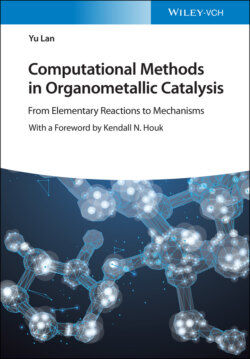Читать книгу Computational Methods in Organometallic Catalysis - Yu Lan - Страница 34
2.3.6 Pseudo Potential Basis Sets
ОглавлениеPseudo potential basis sets are widely used in computational organometallic chemistry, which shows a rather high efficiency for transition metals. Pseudo potential basis sets are not to calculate the inner electrons, but to describe the contribution of the inner electrons by a potential, which is placed in Hamiltonian. Pseudo potential basis sets actually include two parts, pseudo potential and the basis sets. The inner electrons adopt effective core potential (ECP), while the outer valence electrons adopt general basis sets. When pseudo potential basis sets are used, inner electrons do not need to be considered directly, so that the consumption of calculation is significantly reduced, which is more obvious for more heavy elements. In transition metal chemistry, relativistic effects mainly come from inner electrons. If the relativistic effect is taken into account in fitting the pseudo potential, that effect can be reflected equivalently in the calculation based on the pseudo potential.
Generally, the pseudo potential basis sets used in computational organometallic chemistry include three categories: Stuttgart pseudo potentials, Los Alamos National Laboratory (LANL) pseudo potentials, and def series pseudo potentials [66, 77–82]. SDD is the most popular Stuttgart pseudo potential basis set, which often are used to describe the atomic orbitals of transition metals in the fifth and sixth periods. The accuracy of SDD is roughly equivalent to a triple‐zeta basis set.
LANL series pseudo potentials were proposed by Hay and Wadt in 1980s, which involve relativistic effect for the elements in the fifth and sixth periods. The frequently used double‐zeta LANL series basis set is LANL2DZ [81]. LANL2TZ is restricted from LANL2DZ, which is a quasi‐triple‐zeta basis set [82]. In LANL2TZ+ or LANL2TZ(f) basis set, diffuse function or polarization function is involved, respectively. LANL08 is a completely derestricted basis set based on LANL2DZ. Diffuse function or polarization function also can be involved in LANL08+ or LANL08(f), respectively. Even now, LANL2DZ basis set has been widely used; however, it is not recommended because of its obviously low accuracy. For transition metals, LANL2TZ(f) and LANL08(f) are recommended because of great improvement in accuracy though it is slightly expensive [83].
The accuracy of def2 series basis sets increases from def2‐SV(P), def2‐SVP, def2‐TZVP, def2‐TZVPP, def2‐QZVP, and def2‐QZVPP [83–87]. For the first four periods, def2 series basis sets are full electronic basis set. From the fifth period, they become pseudo potential basis sets, which are combined with Stuttgart small core pseudo potential. The main advantage of the def2 series basis set is that it covers all elements in the first six periods; therefore, def2 series basis set can be used solidly in most systems instead of a mixed basis set. In computational organometallic chemistry, def2‐TZVP basis set is suggested in energy calculation.
